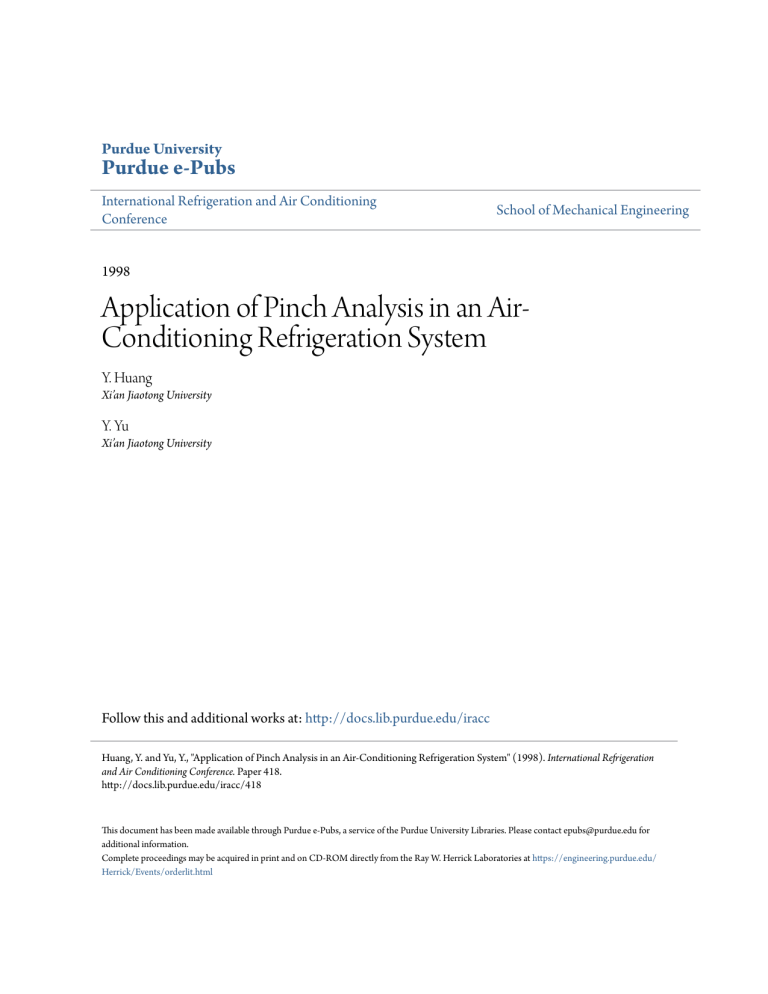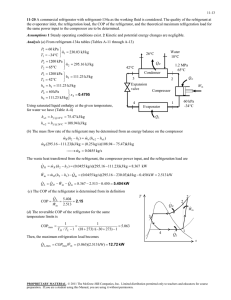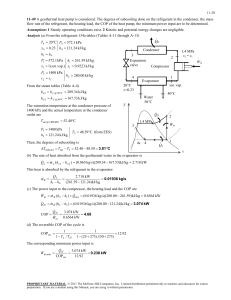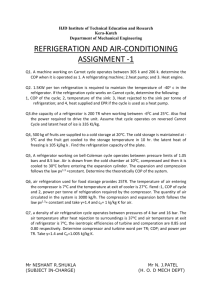Application of Pinch Analysis in an Air-Conditioning - Purdue e-Pubs

Purdue University
Purdue e-Pubs
International Refrigeration and Air Conditioning
Conference
School of Mechanical Engineering
1998
Application of Pinch Analysis in an Air-
Conditioning Refrigeration System
Y. Huang
Xi’an Jiaotong University
Y. Yu
Xi’an Jiaotong University
Follow this and additional works at: http://docs.lib.purdue.edu/iracc
Huang, Y. and Yu, Y., "Application of Pinch Analysis in an Air-Conditioning Refrigeration System" (1998).
International Refrigeration and Air Conditioning Conference.
Paper 418.
http://docs.lib.purdue.edu/iracc/418
This document has been made available through Purdue e-Pubs, a service of the Purdue University Libraries. Please contact epubs@purdue.edu for additional information.
Complete proceedings may be acquired in print and on CD-ROM directly from the Ray W. Herrick Laboratories at https://engineering.purdue.edu/
Herrick/Events/orderlit.html
APPLICATION OF PINCH ANALYSIS IN AN AIR-CONDITIONING
REFRIGERATION SYSTEM
Yundong Huang Yongzhang Yu
School of Chemical Engineering, Xi'an Jiaotong University
Xi'an City, Shaanxi Province, 710049, The People's Republic of China
(Fax: 86-29-3237910, E-mail: zhangzx:@xjtuOl.xjtu.edu.cn)
ABSTRACT
A new method pinch analysis is introduced to discuss design optimization of the air-conditioning refrigeration system from the point of view of saving energy and saving material, and the evaluation principle of system economy is built up. The method avoids the defect of traditional design method using experience, easy to realize optimum match between system component parts. c
Cp
COP
F
G
H
M p
PBP
Q
T,t
Lllp v w p
J[ e
Subscripts: a c t
NOMENCLATURE constant constant pressure specific volume kJ/kg.K coefficient of performance area m
2 mass flow rate kg/s enthalpy kJ/kg penalty factor pressure atm increased capital payback period year heatduty kW temperature ·c
·c temperature difference of pinch-point volume flow rate m 3
/h compression work kW density kg/m
3 pressure ratio error air condenser total r e refrigerant evaporator
INTRODUCTION
With the development of computer technology, simulation and optimization of refrigeration systems are getting possible, and due to facing two problems - the substitution for CFC and the renewal of design methods in the refrigeration field, studies are gradually turned to system simulation, design optimization and system CAD etc ..
For instance, modeling and optimization of refrigeration systems have been listed as prime task in Norway, and many
245
other countries such as America, Japan and Gennan are also active in these aspects.
At present, much work about design, calculation and modeling of refrigeration systems has been most of them use traditional design method with experience, without considering optimum match system from the point of view of saving energy and saving material. Here a new method done
11• 2
1, but of the refrigeration pinch analysis is put fmward to simulate the air~conditioning refrigeration system, when material consumption of heat exchangers is restricted, the system COP can be promoted to the greatest extent. In this way saving energy and saving material are integrated together with an economy index to evaluate the perfonnance of system.
MODELING METHOD
As an energy saving technology, pinch technology has been successfully used in optimization exchanger network
13
•41• Similarly, it can be applied to simulate the air~conditioning of heat system. Fig.l shows the airconditioning refrigerant cycle, comprised of four main process: compression process 1-2, condensation process 2-3-
4-5, expansion process
5~6 and evaporation process 6-7-l.
In most cases, there exists a pinch point between the refrigerant and air both evaporator, at which the temperature difference between the refrigerant and air reaches minimum,
Generally, the pinch point in the condenser lies at T3 and ta3, and T 6 difference ofthe pinch point can be written respectively as Lltcp=
T3-~ and ta
6 in in the evaporator, so the temperature and Llt.,p=ta6-T6. They can not only decide the heat exchanger area (or heat exchanger cost), but also decide COP of the refrigeration system.
The method proposed in this paper emphasizes the concept of the temperature differences of pinch points, using the condenser and the as shown in Fig.2. lltq, and ilt.,p as control parameters to write a program to simulate the air-conditioning refrigeration system in order to achieve optimum match of air-conditioner perfonnance. Fig.3 shows the program flowchart.
During practical design of air-conditioning system, the air is usually required to be cooled from primitive temperature to target temperature, so we can obtain the cooling duty of the evaporator as
Q. = P.,V.'(Ha,- H,6)
(1)
If the pinch-point temperature differences in both condenser and evaporator are given, we have
~=~=~-Ll~
~ = T., = la3
+ Lltap w
(3)
Since the temperature
~ at point 2, 3, 4 and 5 can be decided. For the evaporation temperature is known, so the refrigerant mass flow rate is got
(4)
According to the heat balance, the heat duty required by the air due to the temperature lift from t.s to ta3 is described as
(5)
Consequently, the new condenser air pinch temperature can be so luted
, t,l = t,s +
G,(H
3 -
H
<
P.sva Cpa
5 )
(6)
(
03
Then comparing with the previous value
~. if
\t~ 3
1
03 \
> e, another iteration will be required using
= t~ 3 until the convergence condition is satisfied. Thus we can calculate each parameter, such as Qe,
W, COP, n , Fe, Fe, Ft.
(7)
Where
246
COP== Q. w p2
7 C = -
~
F,=F._+Fc
(8)
(9)
(10)
EXAMPLE AND ANALYSIS
The proposed method has been applied to design optimization of the refrigeration system of type KLD29 train air-conditioner. The known design parameters are as follows: in the evaporator, the air flow volume
Va' the air inlet temperature ta
1
= 25
·c, the air outlet temperature t
06
=
12
·c;
=
2500m
3 I h, in the condenser, the air flow volume
Vac = 5000m
3 I h, the air inlet temperature t
05 the refrigerant is R22.
= 35 'C, superheat degree .M,.p = 10
·c, subcooling degree lit,,b
= 8.3 ·c,
Fig.4 demonstrates the changes of system COP and total heat transfer area Ft (including evaporator and condenser) with the two controlling parameters- L1tq, and L1tcw
It can be seen that as L14v or L14v decreases, COP and
Ft both increase smoothly, but more sharply when L14v and L1tcp are small. If the system COP is considered separately, the smaller L14p and L1tcp, the greater the COP, but at the same time Ft will increase sharply, causing the rapid increment of the capital of heat exchangers, which may balance out even exceed the profits brought by the increase of COP.
EVALUATION PRINCIPLE
The above analysis shows there is a trade-off between COP and heat exchanger area. When pinch method is used to simulate refrigeration systems, Fig.5 gives the change of system COP with total heat transfer area Ft. It can be seen that COP increases with total area, and the curve has a steep start, then getting more and more even as total area continues to increase. Therefore, even ifthe size ofheat exchanger is enlarged further, the improvement of COP would be little, so economically it's very disadvantageous. In a design process, the dependent relation between COP and heat exchangers area should be fully considered in order to realize optimum system economy, so the evaluation principle of system economy - increased capital payback period must be built up.
On the basis of the original refrigeration system, if the size of heat exchangers is enlarged, the capital cost of system will increase, also the system COP will be improved, which lowers the cost of operation. Therefore, we may as well discuss the payback period of the increased capital cost cluing to the size enlargement of heat exchangers£
5
•
6
1.
If we know the increased capital cost L1P, the annual average cooling duty Qo, the annual running hours h, the lifespan of system n, the price of electric energy input CE, the motor efficiency llmo• and the original system performance CO Po, then the yearly increased capital cost is got (the unit is
¥ lkw). tJ.P' = CF In
(11)
Where CrL1P/Q
0, represents the increased capital cost per unit cooling duty.
For a refrigeration system, the price of per unit cooling duty can be described as(¥ lkw.h) c
CE bY'
A=
1JmoCOP
+h
(12)
While in the original system, it becomes that
CE
1lmoCOPo
Then, the payback period can be deduced as follows:
(13)
247
(14) = PBP= CF h(Co -CA) hCE
CF (-1 ___ 1_) _ n
TJ .. " COP, COP
Since the cost of heat exchangers AP increases with the heat transfer area AF, they should satisfy a certain correlation, supposing
AP=CH·M'
(15)
Where CH represents the cost increased by enlarging unit heat transfer area, it varies with different materials.
Now the increased capital payback period for above example parameters
(C~200~250 Y 1m
2
,
CE=0.45~0.60 will be discussed by incorporating some typical
Y lkw.h, n=lO, 1lmo=0.75, h=6000), and supposing the original pinch~ point differences are Aiep =10
·c, Aiep =10
·c.
Fig.6 gives the changes ofPBP with Atep,Atcp when CH=200 and
CH=250. It is seen that as Atep decreases, PBP descends sharply at ftrst, and smoothly when Atop
~ 6
·c;
whereas the greater Atcp• the more advantageous, because
PBP descends as Atop increases. Considering the overall effects be decided to lower PBP to the greatest extent. For this example, of Aiep, Atcp on PBP, the values of Atop and Atop can choosing A4v =5 within 0.45~0.60 ¥
·c
and Atep =8
·c
is more suitable. lkw.h, and the upper, the lower
The filled areas show the changes of PBP when CE floats boundary curve is drawn respectively when CE=0.45
¥ lkw.h and CE=0.60 ¥ lkw.h, so the .fact that PBP becomes shorter when CE increases is seen. Besides, PBP is much affected by CH, which gets longer when CH increases.
It is noted that when the size of heat exchangers increases, capacity will decrease if the cooling duty is kept identical, so the refrigerant mass flow rate and compressor the motor and compressor with smaller capacity can be chosen. Since the above calculation didn't allow for this, the results are conservative.
OPTIMAL DESIGN
As shown in Fig.5, the system COP increases with total area would have a great potential even if within the same total area of heat exchangers, and the improvement of COP
(or the same total cost).
It is seen that when Ft=l20m
2
,
·c,
which mainly results from the distribution of the COP value at Atep=2
·c is 15.3% higher than that at Atep=lO the total area between evaporator and condenser. Although the total area is given, the area of evaporator or and condenser pinch-point temperature differences, condenser could change through controlling the evaporator accordingly the system COP also changes. Therefore, the optimization target can be built up
COP of the refrigeration system is acquired under certain total area (or under the fixed cost). as follows: the optimal
This optimization aims at lowering energy consumption, therefore the objective function can be defmed as the reciprocal of COP, that is
1 f =COP
While COP is related to Aiep and Atcp, then the mathematical expressions minf(At,P,
!Yep) can be written as
0 6)
{17)
{ s.t.
F,(~t.p,&'cr)
= C f(&,r,Mcp}' which can be converted to an unconstrained
Equation (17) is a constrained problem to minimize problem with exterior penalty function strategy. Here the penalty function is introduced(']
F(M•r'~t'P, M)
= f(&-,r,~tcp)
+
M(F,(~t.r,Atcp)cf
{18)
So long as the unconstrained minimum value of
F(~t•P'~t'P' M) is solved, the optimization solution is then got.
This is a two-dimensional, non-linear optimization problem existence of constraint condition, there is only one independent with one equality constraint. Owing to the parameter of the two variables -Alep and Atop- The
248
value of COP can be obtained by searching lltep and lltop within the boundary range respectively.
· The optimal design of system COP with different total heat transfer area is discussed in details, as shown in
Fig. 7. It can be seen that, although the total area is given, the system COP may change by controlling the evaporator and condenser pinch-point temperature differences. The three-dimensional curves show the changes of COP with lltep and llt.P, when lltep is small and lltop is great, the refrigeration system can acquire high COP. Therefore, the optimal design can be achieved by diminishing the evaporator pinch-point temperature difference as possible as we can.
Fig.8 illustrates both evaporator and condenser heat transfer area changes with lltep under certain total area. As
~t.P decreases, the evaporator fm area increases, while the condenser fm area decreases. For smalllltep can bring high COP, the size of evaporator should be enlarged further to promote system COP to the greatest extent if the total heat transfer area is defmite.
CONCLUSIONS
Pinch analysis not only can be applied to optimization of heat exchanger network, but also can be applied to design optimal refrigeration system. Pinch analysis is used in this paper to discuss optimal design of the airconditioning refrigeration system from a point of view of saving power and saving material. When material consumption of heat exchangers is constant, the COP value can be promoted to the greatest extent to save energy.
Accordingly the evaluation principle of system economy is built up to guide optimal design of an air-conditioning system. The method aims at saving power and saving material in a refrigeration system, and avoids the defect of traditional empirical design method, which is easy to realize optimum match between component parts. The program is simple, and satisfactory results can be obtained when the method is used to the matched design of an airconditioning refrigeration system.
REFERENCES
[1] H.Yasuda, eta!., Simulation Model of a Vapour Compression Refrigeration System, ASHRAE Trans., 1983, No.2787
[2] P.Domanski, D.Didion, Simulation of a Heat Pump Operating with a Nonazeotropic Mixture, Int.
J. ofRefrig.,Vol.7 No.4,
1984
[3] X. Feng, Work Target ofHeat Engines and Heat Pumps in process Integration, ECAC'95, London, 1995
[4] X. Feng, Q.L. Li, The
Q -H Diagram and Its Application in the Compression Refrigerator, Proceedings, 8th National
Thermodynamic Analysis and Energy Saving Symposium, Chengdu, 1996
[5] Y.Z. Yu, Principle and Application of Heat Pumps, Machinery Industrial Publishing House, 1993
[6] X. Feng, T. Bemtsson, Critical COP for an Economically Feasible Industrial Heat-Pump Application, Applied Thermal
Engineering, Vol.17No.1,pp93-101, 1997
[7] K.C. Zhang, Calculation and Analysis of Optimal Engineering, Xi'an Jiaotong University Publishing House, 1988
[8) G.Q. Huang, Z.J. Cheng, Preliminary Study on Simulation and Optimization for a Car Air-Conditioning Refrigeration
System, J. ofRefrig., No.3, 1991
249
p srart
T
Figure I The Air-Conditioning
Refrigerant Cycle calculate Qe and Fe; give initial value to ta3
5.0
~
4.5 u
4.0
Figure 2
H results output:Qe,W,COP,Fe,Fc,Ft
(. end )
Figure 3 The Program Flowchart
150
140
10
Figure 4 The Changes of COP and Ft with
L\t.p, L\tcp
5.25
5.00
~
0:::.
~;.:.
4.75
4.50
4.25
4.00
3.75
3.5090
100 110 120
F t ( m2)
130 140 150
Figure 5 The Change of COP with Ft
250
10
4
PBP 3
[J IY"'=4°C
§)
IY"'=6°C
[8
&..,=8'C
I
'
\
5 IZZl
Atq,=4 "C
0/!Jep=fJ "C
PBP 4
D /!Jep=S "C
3 r--,-...,......,.....,....,..-,-~:-:-
I
4.5
4.4
4.3 u
4.2
4.1
4.0
CIF200
Figure 6 The Increased Capital Payback Period
CIF250
4.8
4.7
0 u
4.6
(a)
(b)
Figure 7 The Change of COP with .:lt,p, .:ltcp When the Total Area is Definite
(a) Ft=ll0m 2
(b) Ft=120m
2 r-" 60 r:."
40
80
2
- • - Evaporator
- A Condenser
___.--
-""
--.
---.
4
....
-
.a.--""
6
--·-·
8 10 t.t
•p i
1 0 0 . - - - - - - - - - - - --.
- • - Evaporator
80 r-" r:."
60
40
-.a.-
.a.-"" .
2
Condenser
_-A-""--
---.
4
--
6
·-·
.a.-"'
-·
8 10
~.p
(a)
(b)
Figure 8 The Changes of Evaporator and Condenser Fin Area with .:ltep
(a) Ft=I 10m
2
(b) Ft=I20m
2
251




